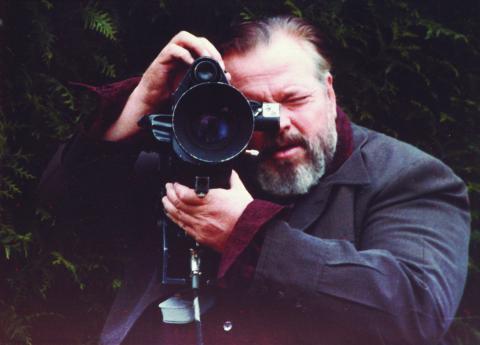Evan Davis on Welles's CONFIDENTIAL REPORT (MR. ARKADIN) & F FOR FAKE

This essay discusses Orson Welles' Confidential Report (aka Mr. Arkadin, 1955) and F for Fake (1973) and was written by UW Alum and former Cinematheque staff member Evan Davis. Both films screen in original 35mm prints on Saturday, February 21, beginning at 7 p.m. in our regular venue, 4070 Vilas Hall.
by Evan Davis
Confidential Report (Mr. Arkadin)
Borges once said of Citizen Kane (1941) that the film was "a labyrinth with no center." A provocative and partially true statement, no doubt. At the very least, Orson Welles's first featureexists as a stable text that can be viewed as its director intended for it to be seen. The same cannot be said for Mr. Arkadin (aka Confidential Report).
As many as six versions of the film are extant, none of which were fully edited by Welles. Each has different footage and a different editing structure. Very little documentation of Welles's intentions is available, making a reconstruction damn near impossible. It is, in a lot of ways, themost unknowable film Welles ever made. At least there is a record of how The Magnificent Ambersons, The Lady from Shanghai, and Touch of Evil were supposed to look, sound andfeel like. If ever there was a labyrinth with no center in the Welles canon, Mr. Arkadin is it. That is oddly appropriate--the story of a man hired to find out the story of a man's life is a perverse echo of Citizen Kane, with inflections of The Third Man mixed in throughout. The version that you will see is the European release cut, re-titled Confidential Report. Missing is the more rigorous flashback structure we know Welles intended, along with the addition of Guy Van Stratten's (Robert Arden) voiceover, which Welles did not want to use. What remains is a grotesque, satirical thriller about amnesia, white slavery and the Electra complex.
There arepassages of weird, undeniable beauty, like Van Stratten's snow-filled approach to Jacob Zook's (Akim Tamiroff) apartment; the wide-angle clutter of Trebitsch's (Michael Redgrav) workshop; the confrontation between Arkadin (Welles) and Milly (Patricia Medina); and the final meeting between Arkadin and Zook, where one cannot help but laugh and weep at the thought of old age. It's as weird and unstable as Welles ever got.
F for Fake
There are three masterpieces in Welles's career that each signify a phase of his work. The first is Citizen Kane, the apotheosis of his Hollywood period. The second is Chimes at Midnight (1966), the apex of his achievements in European independent cinema. The third, and the crown jewel of his late, essayistic phase, is F for Fake (1974).
To the naked eye, F for Fake might seem like a departure for Welles. It is his first completed theatrical documentary, full of lightning-fast cutting and non-narrative digressions. A closer look reveals this to be perhaps Welles's great thesis statement on his own work. It is "a film about trickery," as Welles states at the beginning. Trickery is too small a word for what he accomplishes. It is an essay about the making of art itself, about the fallacy of authorship, and the crowning of art in the tapestry of human experience. It is the headiest movie about the relationship of art and truth, yet is also the most fun. Few films were more influential.
A little backstory: Elmyr de Hory, the famous Hungarian art forger, was recently outed and living a comfortable life on the island of Ibiza, away from the jurisdictions of more than a few countries where he was wanted for forging Modiglianis, Picassos, and a heap of other European masters. French documentarian Francois Reichenbach began making a fairly anodyne film about de Hory and his biographer, journalist Clifford Irving. But then Irving himself was outed as a forger, having faked an autobiography "by Howard Hughes," the famously reclusive tycoon. This is where Welles stepped in. Welles took Reichenbach's footage, re-edited it, and added in material of his own. Welles films himself at an editing table, literally making and re-making the film as it goes along (a technique Godard would use in his films only a few years later). He digresses about Hughes's life, Welles's own life, and finally arrives at the conclusion that while artists and authorship may be a fluid and dubious concept, the artworks themselves must be heralded as one of the only things humanity has left to hold onto. You see, only through the lens of the fake can one finally arrive at the real. Nothing is more important than the truth; sometimes, you have to lie to get to it. I love this film more than words can say. I hope you love it, too.
